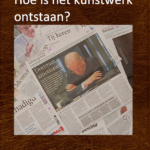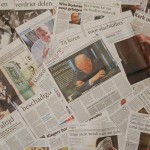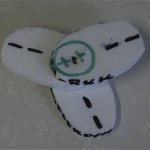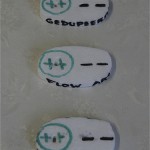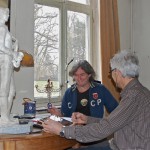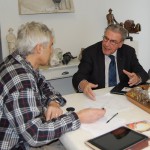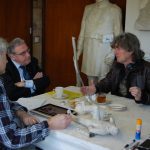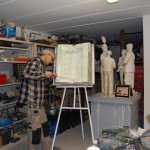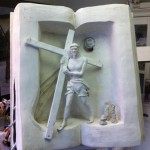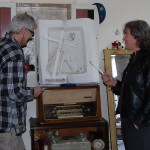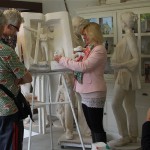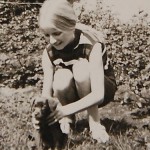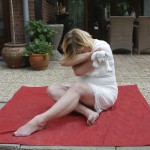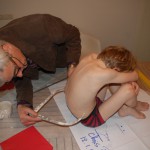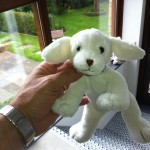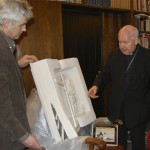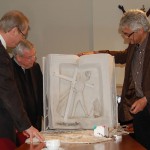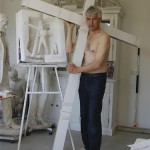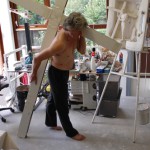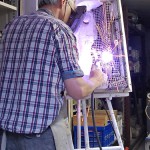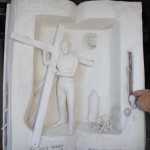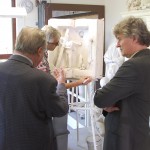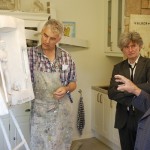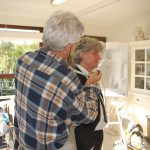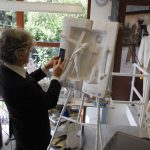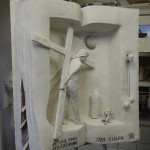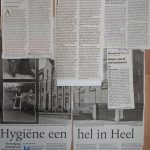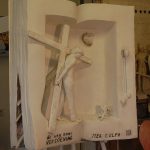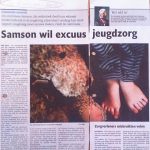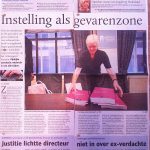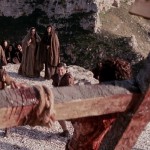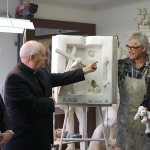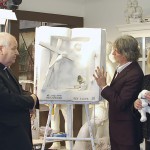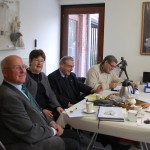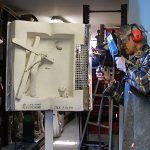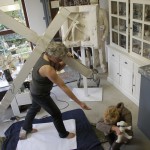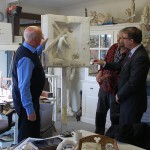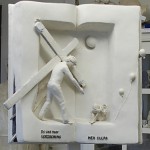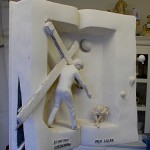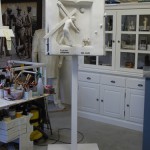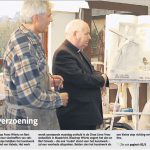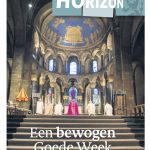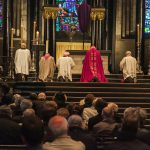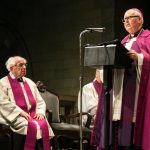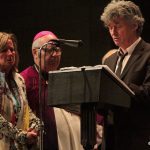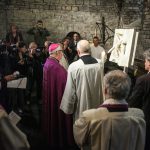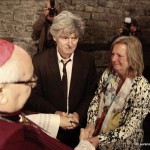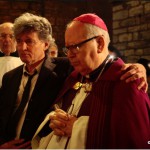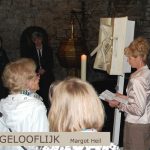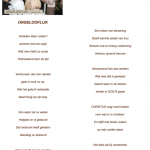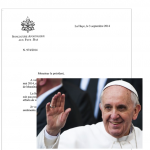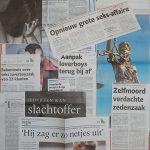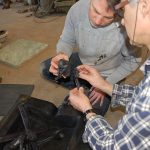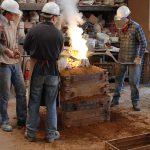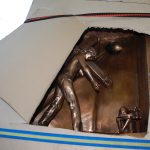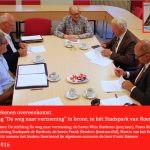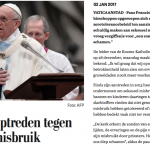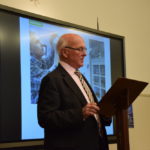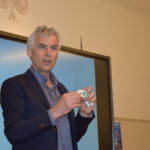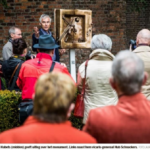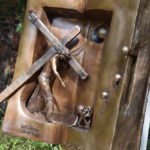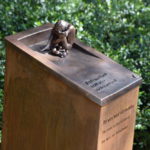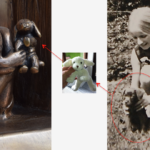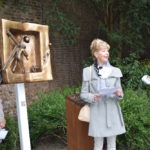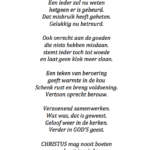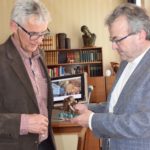The origin of the artwork
![]() In December 2011 the former Secretary of State, Mr Deetman, presented the report of his inquiry into sexual abuse within the Roman Catholic church. According to the report there were between 10,000 and 20, 000 victims in the Netherlands. Pierre Habets was appalled and it seemed to him as if nothing good at all could any longer be found in the faith. He realised ,however, that there are millions of people all over the world who feel genuinely supported by the Catholic faith every day. Nobody has ever denied that, and thus the idea of the artwork arose. He then contacted representatives of the church, specifically bishop Frans Wiertz and Bert Smeets, the chairman of Mea Culpa United. They were willing to talk to him, they talked together and visited the the artist`s studio several times. Habets was deeply touhced by their meeting, and already at the beginning of 2012 became convinced that it might be possible to find a positive connection, start a search for what connects people when they were willing to listen to each other with an open mind. On the basis of these first dialogues Habets considered what he could do, and he came up with a design made of polystyrene foam and gypsum. He showed this to people and listened to what they said about it, and especially to what they did not say. This experience led to a new design. In the end he has been working on it for seven long years, and now the endresult in bronze can be seen at the municipal park of Roermond. Habets does not make drawings, he works with experimental models, and he does not stop modelling until the final result has been attained. For instance, in the original clay model you can see that the Christ figure is in walking motion and holds out his hand tot he child. Habets is proud and honoured that the foundation has even received a letter from Pope Frances, in which the pope expresses his appreciation of the project. Through this project a piece of history has been written. The project means quite a lot to Habets. He sees it as a great accomplishment, the completion of a seven-years` path. At the same time it is a beginning, because the work can now start doing what it was designed to do, now in bronze, in the municipal park, because it is also a clear sign of recognition. It is tangible, it is made of bronze. It is acknowledged that things have happened that never should have happened. And… children have lost their childhood. Thus a memorial has been created which can help prevent a repitition of the past and provide a hopeful view of the future, The Road to Reconciliation.
The photobook
The photobook shows the endresult in bronze as it can be seen at `De Kartuis` a municipal park in Roermond in the south of the Netherlands. When you move the cursor to photobook you can click on the slanted white arrows. The photobook will then fill the screen. By clicking again on the white arrows (top right), or using the esc button on your computer you can close the screen.
In December 2011 the former Secretary of State, Mr Deetman, presented the report of his inquiry into sexual abuse within the Roman Catholic church. According to the report there were between 10,000 and 20, 000 victims in the Netherlands. Pierre Habets was appalled and it seemed to him as if nothing good at all could any longer be found in the faith. He realised ,however, that there are millions of people all over the world who feel genuinely supported by the Catholic faith every day. Nobody has ever denied that, and thus the idea of the artwork arose. He then contacted representatives of the church, specifically bishop Frans Wiertz and Bert Smeets, the chairman of Mea Culpa United. They were willing to talk to him, they talked together and visited the the artist`s studio several times. Habets was deeply touhced by their meeting, and already at the beginning of 2012 became convinced that it might be possible to find a positive connection, start a search for what connects people when they were willing to listen to each other with an open mind. On the basis of these first dialogues Habets considered what he could do, and he came up with a design made of polystyrene foam and gypsum. He showed this to people and listened to what they said about it, and especially to what they did not say. This experience led to a new design. In the end he has been working on it for seven long years, and now the endresult in bronze can be seen at the municipal park of Roermond. Habets does not make drawings, he works with experimental models, and he does not stop modelling until the final result has been attained. For instance, in the original clay model you can see that the Christ figure is in walking motion and holds out his hand tot he child. Habets is proud and honoured that the foundation has even received a letter from Pope Frances, in which the pope expresses his appreciation of the project. Through this project a piece of history has been written. The project means quite a lot to Habets. He sees it as a great accomplishment, the completion of a seven-years` path. At the same time it is a beginning, because the work can now start doing what it was designed to do, now in bronze, in the municipal park, because it is also a clear sign of recognition. It is tangible, it is made of bronze. It is acknowledged that things have happened that never should have happened. And… children have lost their childhood. Thus a memorial has been created which can help prevent a repitition of the past and provide a hopeful view of the future, The Road to Reconciliation.
The photobook
The photobook shows the endresult in bronze as it can be seen at `De Kartuis` a municipal park in Roermond in the south of the Netherlands. When you move the cursor to photobook you can click on the slanted white arrows. The photobook will then fill the screen. By clicking again on the white arrows (top right), or using the esc button on your computer you can close the screen.
![]()
Fotoboek
- DEC 2011: aanleiding, 10.000 – 20.000 Nederlandse slachtoffers …
- … zeer negatieve publiciteit voor de RKK. Er ontstaat de indruk dat er niets meer goed is aan het (RKK) geloof
- DEC 2011: Initiatiefnemer Pierre Habets vraagt zich af of er toch nog een gemeenschappelijk positief deel bestaat, dat zou de basis zijn voor het te ontwikkelen kunstwerk …
- … of zijn alle slachtoffers “kerkhaters” geworden?
- JAN 2012: Kennismaking met woordvoerder Mea Culpa United, de heer Bert Smeets
- JAN 2012: deken Jos Schreurs bezoekt het atelier ter eerste afstemming
- JAN 2012: deken Jos Schreurs EN Bert Smeets bezoeken SAMEN het atelier en bewijzen beiden het het vermogen te hebben tot oprecht luisteren naar elkaar!
- … vervolg, oprecht luisteren naar elkaar …
- FEB 2012: Pierre aan de opbouw van het eerste “boek”
- FEB 2012: het eerste ontwerp, “Christus” nog met lendendoek, christus loopt nog van kind af en reikt nog niet zijn hand naar het kind.
- FEB 2012: Bert Smeets geeft zijn visie op het eerste ontwerp
- … slachtoffer Anita Bosch-Wiss bezoekt samen met Bert Smeets het Flow Art atelier en helpt mee met de verdere ontwikkeling van het kunstwerk
- MRT 2012: kennismaking met slachtoffer Anita Bosch-Wiss met haar eigen hond Dinky, haar troost en vlucht voor die akelige kinderwerkelijkheid van destijds …
- … Anita als eerste hulpmodel voor het “kind” …
- … het derde hulpmodel voor het kind, in de uiteindelijke houding, zodanig gemodelleerd dat het kind zowel een jongen als een meisje kan zijn! Het hoofd afgeschermd uit schaamte!
- … opmeten van het hulpmodel voor “het kind”
- … knuffel Dinky, als symbool voor de “verloren kindheid” gebaseerd op het bijzondere slachtoffer verhaal van Anita Bosch-Wiss
- MRT 2012: bisschop Frans Wiertz in overleg met initiatiefnemer Pierre Habets over het eerste ontwerp. Zo ontstond onder andere het idee van Christus met jeans in plaats van de lendendoek
- APR 2012: in overleg met het dekenaat Maastricht, links Mr Joseph Goumans en in het midden deken Hanneman. Toen ontstond het idee om juist een slachtoffer te vragen als hulpmodel voor de Christus-figuur!
- MEI 2012: Pierre zelf als eerste hulpmodel voor de ruwe opzet van de Christus-figuur
- AUG 2012: Bert Smeets, de woordvoerder van slachtoffervereniging Mea Culpa United als hulpmodel voor de Christus-figuur, een slachtoffer als hulpmodel naar idee van het dekenaat Maastricht
- AUG 2012: idee Pierre: er “moet” iets” van beweging gerealiseerd worden n.a.v. zeer positieve kinderreacties op beweging bij ander “beweegbeeld”. Dat werd de ballon en Dinky!
- … tweede ontwerp, met beweging van de ballon en Dinky. Symbolisch krijgt het kind haar verloren kindheid weer terug!
- AUG 2012: deken Jos Schreurs, Bert Smeets en Pierre Habets weer in het atelier voor overleg en vormgeving op basis van ontwerp 2
- … vervolg overleg tweede ontwerp
- … vervolg overleg tweede ontwerp
- … deken Jos Schreurs: … “zou de Christus-figuur een hand kunnen reiken naar het kind? Zo ontstond het idee en werd de Christus-figuur in de compositie gedraaid, met de volle aandacht en met reikende hand naar het kind
- SEP 2012: Bert Smeets blijkt desgevraagd bereid te zijn om buiten het vele wat hij al doet voor dit project, ook nog bereid hulpmodel te zijn voor de Christus-figuur. De foto toont het opnemen van enkele referentiematen
- SEP 2012: …
- SEP 2012: Bert Smeets bezoekt weer het atelier en bekijkt het derde ontwerp, de Christus-figuur kijkt naar “het kind”
- SEP 2012: derde ontwerp
- SEP 2012: De jongens van Heel
- OKT 2012: …
- OKT 2012: Presentatie rapport Commissie Samson
- OKT 2012: vervolg, Presentatie rapport Commissie Samson
- OKT 2012: het kruis uit de film “The Passion of the Crust”, als inspiratiebron voor de vorm
- NOV 2012: ontwerpvrijgave in het Flow Art atelier
- NOV 2012: overtuigende ontwerpvrijgave door bisschop Frans Wiertz, Bert Smeets, Anita Bosch-Wiss en Flow Art
- JAN 2013: De Stichting De weg naar verzoening, heeft de volgende bestuursleden, v.l.n.r. op foto: drs.F.G.J.M. (Frans) Beckers – voormalig burgemeester van Schinnen tevens voorzitter, mevr. C. (Corrie) Bel van Tilborgh – tevens bestuurslid Mea Culpa United, mgr drs M.G.G.J. (Jos) Schreurs – tevens deken van Schinnen en dhr W.G.J. (Wim) Diederen – secretaris/penningmeester
- … het complete Stichtingsbestuur van de Stichting De weg naar verzoening
- OKT 2013: …
- OKT 2013: de uiteindelijke compositie, de Christus-figuur reikt de hand naar het kind.
- JAN 2014: v.l.n.r.: de heer Frans Beckers, Pierre Habets en Matheu Bemelmans, de woordvoerder van het bisdom Roermond
- MRT 2014: …
- MRT 2014: …
- MRT 2014: …
- APR 2014: …
- APR 2014
- APR 2014: …
- APR 2014: …
- APR 2014: vrz Mea Culpa United spreekt tijdens de boetedienst voorafgaand aan de inzegening DwnV
- APR 2014: …
- APR 2014: inzegening De weg naar verzoening n de Onze Lieve Vrouwe Basiliek te Maastricht. Tijdens de boetedienst door bisschop Frans Wiertz in samenwerking met Bert Smeets en Anita Bosch-Wiss
- APR 2014: … sfeerbeeld inzegening De weg naar verzoening
- APR 2014: … sfeerbeeld inzegening De weg naar verzoening
- APR 2014: … sfeerbeeld inzegening De weg naar verzoening
- APR 2014: schrijfster Margot Heil draagt haar gedicht “Ongelooflijk” voor tijdens de inzegening DwnV
- … gedicht Ongelooflijk van Margot Heil
- SEPT 2014: Paus Franciscus heeft persoonlijk laten weten dat hij waardering heeft voor de inspanningen van de Stichting DwnV voor de slachtoffers van seksueel misbruik
- JAN 2015: Loverboy affaire Valkenburg in de openbaarheid
- FEB 2015: Pierre bespreekt het wasmodel met de bronsgieter
- … het bronsgieten
- MRT 2015: detail ruwe brons
- DEC 2015: detail uiteindelijke brons, plaatsingsgereed
- SEP 2016: …
- JAN 2017: Paus eist optreden tegen seksueel misbruik
- APR 2017: vrz Frans Beckers opent de bijeenkomst
- APR 2017: initiatiefnemer geeft toelichting over het ontstaan van De weg naar verzoening
- APR 2017
- Detail bronzen eindresultaat, de zuil met kind
- Dinky als symbool voor de verloren kindertijd
- APR 2017: Margot Heil draagt haar gedicht “Ongelooflijk” voor ter afronding van de onthullingsceremonie in het Stadspark De Kartuis te Roermond. Idem in APR 2014 in de OLV Basiliek te Maastricht.
- 2019: bisschop Harrie Smeets (rechts) in gesprek met Pierre Habets
- MEI 2019: Uitreiking Wilhelmina Sangers Cultuurprijs 2019
